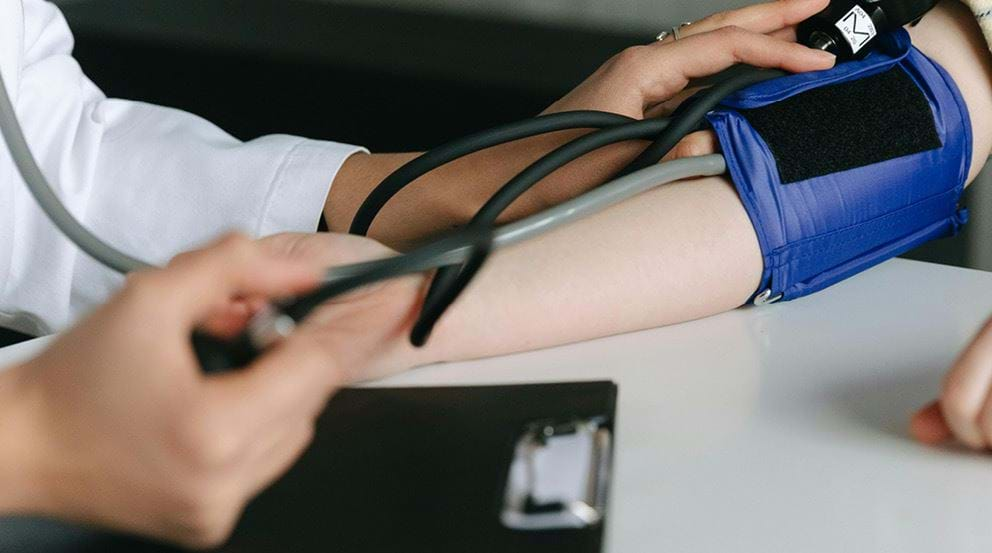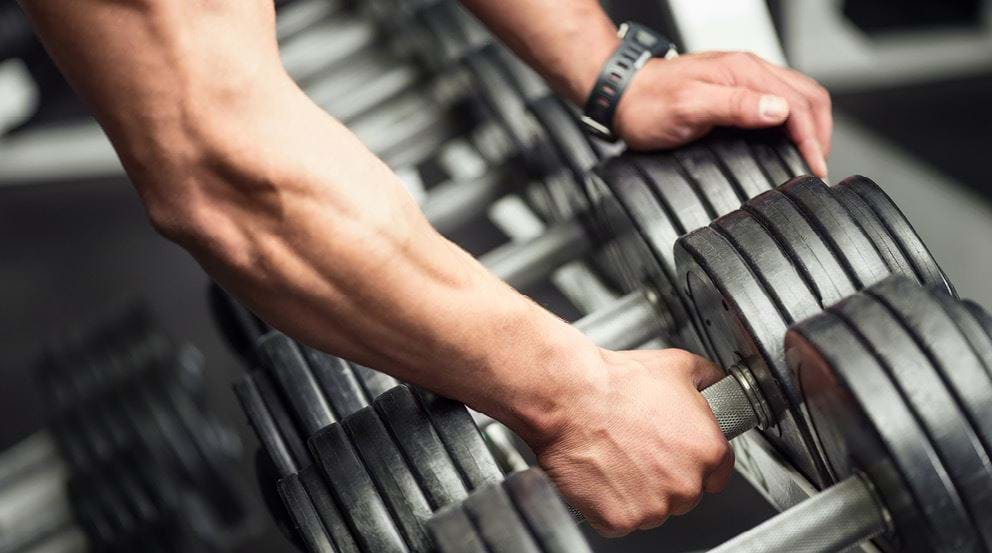Weight Training and Blood Pressure: What You Need to Know

Weights And Blood Pressure | Benefit Of Weight Training | Risks | Training Tips | Best Exercises | Guidance | FAQs
Regular exercise is one of the best ways to look after your heart and circulatory health, including your blood pressure. But what about weight training? You might have heard that lifting weights can cause or worsen high blood pressure and are wondering if it's safe to do.
This guide answers common questions and concerns and breaks down weight training blood pressure advice, including training tips and best exercises to do if you have high blood pressure.
How Weight Training Affects Blood Pressure
Weight training has a two-fold effect on blood pressure:
Short term
When you lift weights, your blood pressure temporarily increases. This weight training high blood pressure is a normal physiological response to your body pumping more blood to your muscles and is something that happens with aerobic exercise too. Blood pressure will return to normal after a few hours and can even drop below your normal resting blood pressure after that.
Long term
Multiple studies [1,2,3] have found regular resistance training significantly improves blood pressure in people of all ages, both in people with a healthy blood pressure and those who are prehypertensive and hypertensive. Different studies show different results but have shown systolic blood pressure (the top number) to be reduced by 3-8mmHG and diastolic blood pressure is reduced by 2-10mmHG.
While these seem small, just a 5mmHG reduction in blood pressure can reduce the risk of developing cardiovascular events by 10%. Combining training with other lifestyle changes such as diet can have a dramatic effect on blood pressure and heart health.
5 Benefits of Strength Training for Blood Pressure
There are many health benefits of weight training, but it is an incredible tool for people with or at risk of high blood pressure for several reasons.
Improved Vascular Function
Regular weight training improves the elasticity of blood vessels so they dilate and contract more efficiently. This helps maintain healthy blood pressure levels throughout the day.
Reduced Arterial Stiffness
As we age, our arteries naturally become stiffer, which can contribute to higher blood pressure. Strength training has been shown to slow or even reverse this process, improving blood pressure regulation.
Healthier Body Composition
Weight training builds muscle and can help to reduce body fat. Excess body fat is linked to hypertension, and improved body composition has direct positive effects on blood pressure management.
Lower Resting Heart Rate
Regular strength training strengthens all your muscles – including the heart. A stronger heart can pump more blood with each beat, which leads to a lower resting heart rate (and, usually, lower blood pressure).
Stress Reduction
Weight training is a good way to lower stress hormones like cortisol that contribute to high blood pressure. Strength workouts also release endorphins that improve mood to help you stick to the healthy habit.
Potential Risks: Blood Pressure And Lifting Weights
While the long-term effects of blood pressure and weight training are positive, people with prehypertension and hypertension do need to exercise caution.
During a lift, blood pressure can spike temporarily, especially when you're lifting heavy or bracing (holding your breath during part of the lift). Blood pressure can reach 200/100 mmHg or higher for those few seconds, which isn't a concern for most healthy individuals but could carry some risks if you already have high blood pressure. This isn't exclusive to lifting in the gym - it's important to be aware of this when lifting heavy loads anywhere.
Rather than avoid weight training altogether, this just means you may need to adapt your training in the beginning and be careful with technique. Always seek medical guidance if you've got any concerns.
Best Advice for Strength Training and Blood Pressure
Weight training has long-term health benefits that can improve blood pressure. Here's how to maximise the blood pressure and weight lifting benefits.
- Breathe properly: Some people hold their breath when exercising but holding your breath while lifting can cause high blood pressure spikes. Work at an intensity that allows you to breathe easily and focus on breath control during the lift. A good aim is to exhale during the effort phase of the lift (for example, when standing up from a squat).
- Start light: Lifting heavy weights are more likely to spike blood pressure as it requires a greater intensity. Start with lighter weights that allow you to do 12-15 reps with good form, gradually increasing the weight over time.
- Prioritise form: Using good technique not only prevents injury but also helps manage blood pressure responses. If you are unable to use good technique and form, lower the weights.
- Consider circuits: Alternating between exercises that work different muscle groups can give you all the benefits whilst controlling blood pressure elevations.
- Hypertension and weight training: Track blood pressure before and after training to understand your body's response. If your blood pressure remains high for several hours, it may be that you need to lower the intensity. Don't have a blood pressure monitor at home? We offer free blood pressure checks at our gyms.
Best Strength Exercises for Blood Pressure Management
If you have high blood pressure and are new to exercising, it’s important not to jump straight in to lifting heavy weights. Here are the best strength exercises for blood pressure to start with.
Bodyweight Training
Bodyweight training can be an effective way to build strength, mobility, and endurance, while allowing you to control the intensity and effort. This is a great place to start your exercise journey as it allows you to improve your fitness with a lower risk of blood pressure spikes. Check out our calisthenics exercises for beginners here for ideas.
Resistance Band Exercises
Resistance bands are a great way to add resistance to bodyweight exercises to make them more challenging. Using resistance bands can help to build your strength and endurance so you are ready for weights. Find some of the best resistance band exercises for beginners here.
Machine-Based Training
Weight machines in the gym give you support and stability, so you can focus on proper form and breathing patterns. They're great for building muscle and learning good technique which can help if you decide to graduate onto free weights. We've shared some of the best resistance machines to try here.
Dumbbell Training
If you're ready to train with free weights, start with dumbbells. These come in lighter weights than barbells so you can choose an easier weight to begin with, meaning you don't need to hold your breath or put maximal effort into the lift. Why not start with this dumbbell workout for beginners?
Isometric Exercises
A 2023 study found that isometric exercises may be more effective at lowering blood pressure than other forms of exercise, with wall sits even more effective than cycling and running. Including these exercises in your workouts is a great way to boost the blood pressure benefits.
Combine Strength Training with Other Exercise
A great way to manage your blood pressure and build heart health is to do weight training, cardiovascular exercise (like walking, running, cycling), plus some flexibility and mindfulness training like yoga. A great blend would be 2-3 strength sessions per week, 150 minutes of moderate cardio, and a few short sessions of yoga or stretching.
When to Be Cautious and When to Seek Advice
While weight training is generally safe for blood pressure, there are some signals that you should slow down or seek professional guidance. If your blood pressure consistently reads above 140/90 mmHg, or you’re on blood pressure medication, consult your doctor before starting a strength training plan. If you feel dizzy, get a severe headache, or experience chest pain during workouts, stop and seek medical attention.
Frequently Asked Questions
Studies show improvements in resting blood pressure after 8-10 weeks of consistent strength training. These improvements only last as long as you are exercising, so it’s important to keep up with your routine over time.
Generally yes, but certain medications like beta-blockers can affect your heart rate response. Always inform your doctor about your exercise plans and monitor how you feel during workouts.
Start with weights that allow you to do 12-15 reps with good form. Gradually increase the weight when you can maintain proper breathing and technique.
Some research suggests blood pressure is higher in the morning, so afternoon workouts might be preferable if you have hypertension. Consistency matters more than timing, so choose a time that helps you stick with your routine.
Many cardiac rehabilitation programs include supervised resistance training. Work with your healthcare team to develop a plan based on your recovery status.
Should You Lift Weights If You Have High Blood Pressure?
Weight training is one of the best types of exercise for long-term health. Even with blood pressure concerns, most people can safely incorporate it into their routine and see benefits for heart health, blood pressure, weight management and more.
Ready to start strength training to help manage your blood pressure? Book a session with one of our Personal Trainers who will get you started safely. Find your nearest PureGym here.


